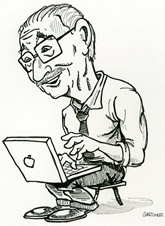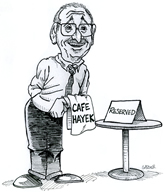Here’s a letter to a new correspondent.
Mr. T__:
Thanks very much for your kind words about Phil Gramm’s and my piece in Friday’s Wall Street Journal.
You write that “even harder to understand [than Pres. Trump’s ignorance of the realities of trade] is Treasury secretary Bessent, who clearly knows that the Trump tariffs are economic nonsense, but continually promotes them.”
I think that this fever of so many American conservatives today for protectionism traces back to the early 1990s when a false account of the U.S. economy began to take hold; ironically, it’s an account that was started and spread mostly by people on the left such as Paul Krugman, Robert Reich, and Larry Mishel. This account is that, although rich Americans continued to enjoy rising prosperity, ordinary Americans’ economic progress came to a halt in the latter half of the 1970s. This timing is convenient for economic interventionists given that, starting in the late 1970s with Jimmy Carter’s administration and extending through the Reagan, Bush I, and Clinton years, the zeitgeist – and much of the reality – turned against high taxes and regulation by government. And, of course, trade continued to become freer.
For more than thirty years now, progressives have blasted Americans with the message, as if it’s a fact as firm as the law of gravity, that ordinary workers’ wages have long stagnated – that while the superrich are getting richer, most of us are treading economic water – that America’s middle-class and industrial economy have been “hollowed out” – that “coastal elites” have sold working-class Americans down some free-market river where they find themselves virtual slaves to globalist forces that drive them to suicide.
Each of these assertions about the U.S. economy and middle-class Americans is not only untrue, it’s the opposite of the truth. See, for example, Michael Cox’s and Richard Alm’s Myths of Rich & Poor (1999), Michael Strain’s The American Dream Is Not Dead (But Populism Could Kill It) (2020), Phil Gramm’s, Robert Ekelund’s, and John Early’s The Myth of American Inequality (2022), Marian Tupy’s and Gale Pooley’s Superabundance (2023), Scott Winship’s “Understanding Trends in Worker Pay over the Past 50 Years” (2024), Gary Winslett’s “Manufacturing is thriving in the South. Here’s why neither party can admit it,” Evelyn Ahdieh’s “Should We Expect Trade-War ‘Wins’ to Save U.S. Lives?,” and others.
Despite the overwhelming evidence against this myth of middle-class stagnation, this myth was peddled persistently by the New York Times, by the Washington Post, by the Los Angeles Times, and by nearly all other major media outlets – print, broadcast, and on-line. If the telegraph were still a thing, it, too, would have been used to spread this myth. Progressives couldn’t repeat it too often.
No wonder, then, that many conservatives eventually began to believe this myth. Pat Buchanan fell for it starting in the early 1990s and Donald Trump rode it all the way to the White House in 2016.
It’s distressing. Today’s ordinary Americans, among the richest human beings ever to breathe – and far richer than were even their parents – seem overwhelmingly to believe themselves to be impoverished and beleaguered by market forces generally, and by free trade especially. And because this myth is a chief reason why Trump is now in the Oval Office, everyone in his administration must continue to pretend that it’s true.
Sincerely,
Donald J. Boudreaux
Professor of Economics
and
Martha and Nelson Getchell Chair for the Study of Free Market Capitalism at the Mercatus Center
George Mason University
Fairfax, VA 22030



